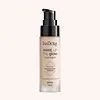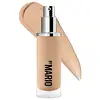What's inside
What's inside
 Key Ingredients
Key Ingredients

 Benefits
Benefits

 Concerns
Concerns

 Ingredients Side-by-side
Ingredients Side-by-side

Water
Skin ConditioningZinc Oxide
Cosmetic ColorantDimethicone
EmollientEthylhexyl Methoxycinnamate
UV AbsorberCetyl PEG/PPG-10/1 Dimethicone
EmulsifyingEthylhexyl Salicylate
UV AbsorberCaprylyl Methicone
Skin ConditioningIsododecane
EmollientTalc
AbrasiveHexyl Laurate
EmollientPolyglyceryl-4 Isostearate
EmulsifyingPentylene Glycol
Skin ConditioningHdi/Trimethylol Hexyllactone Crosspolymer
Phenoxyethanol
PreservativeDiethylhexyl Syringylidenemalonate
Skin ProtectingDimethicone/Vinyl Dimethicone Crosspolymer
Skin ConditioningSodium Chloride
MaskingTriethoxycaprylylsilane
Magnesium Sulfate
Disteardimonium Hectorite
StabilisingSodium Dehydroacetate
PreservativeHydrogen Dimethicone
Benzoic Acid
MaskingPropylene Carbonate
SolventCaprylic/Capric Triglyceride
MaskingDehydroacetic Acid
PreservativeTocopheryl Acetate
AntioxidantAluminum Hydroxide
EmollientGlycerin
HumectantEthylhexylglycerin
Skin ConditioningSilica
AbrasiveSodium Hyaluronate
HumectantScutellaria Alpina Flower/Leaf/Stem Extract
Skin ConditioningCitric Acid
BufferingPotassium Sorbate
PreservativeSodium Benzoate
MaskingTocopherol
AntioxidantCI 77891
Cosmetic ColorantCI 77492
Cosmetic ColorantCI 77491
Cosmetic ColorantCI 77499
Cosmetic ColorantWater, Zinc Oxide, Dimethicone, Ethylhexyl Methoxycinnamate, Cetyl PEG/PPG-10/1 Dimethicone, Ethylhexyl Salicylate, Caprylyl Methicone, Isododecane, Talc, Hexyl Laurate, Polyglyceryl-4 Isostearate, Pentylene Glycol, Hdi/Trimethylol Hexyllactone Crosspolymer, Phenoxyethanol, Diethylhexyl Syringylidenemalonate, Dimethicone/Vinyl Dimethicone Crosspolymer, Sodium Chloride, Triethoxycaprylylsilane, Magnesium Sulfate, Disteardimonium Hectorite, Sodium Dehydroacetate, Hydrogen Dimethicone, Benzoic Acid, Propylene Carbonate, Caprylic/Capric Triglyceride, Dehydroacetic Acid, Tocopheryl Acetate, Aluminum Hydroxide, Glycerin, Ethylhexylglycerin, Silica, Sodium Hyaluronate, Scutellaria Alpina Flower/Leaf/Stem Extract, Citric Acid, Potassium Sorbate, Sodium Benzoate, Tocopherol, CI 77891, CI 77492, CI 77491, CI 77499
Water
Skin ConditioningPolyglyceryl-6 Polyricinoleate
EmulsifyingCoconut Alkanes
EmollientCaprylyl Methicone
Skin ConditioningCetearyl Isononanoate
EmollientPolyglyceryl-2 Isostearate
EmulsifyingGlycerin
HumectantDisteardimonium Hectorite
StabilisingBoron Nitride
AbsorbentDimethicone
EmollientSodium Chloride
MaskingGlyceryl Caprylate
EmollientSilica
AbrasiveCoco-Caprylate/Caprate
EmollientSodium Dehydroacetate
PreservativeLevulinic Acid
PerfumingSodium Levulinate
Skin ConditioningTriethoxycaprylylsilane
Tocopherol
AntioxidantVitis Vinifera Seed Oil
EmollientSqualane
EmollientHelianthus Annuus Seed Oil
EmollientSodium Phytate
CI 77891
Cosmetic ColorantMica
Cosmetic ColorantIron Oxides
Water, Polyglyceryl-6 Polyricinoleate, Coconut Alkanes, Caprylyl Methicone, Cetearyl Isononanoate, Polyglyceryl-2 Isostearate, Glycerin, Disteardimonium Hectorite, Boron Nitride, Dimethicone, Sodium Chloride, Glyceryl Caprylate, Silica, Coco-Caprylate/Caprate, Sodium Dehydroacetate, Levulinic Acid, Sodium Levulinate, Triethoxycaprylylsilane, Tocopherol, Vitis Vinifera Seed Oil, Squalane, Helianthus Annuus Seed Oil, Sodium Phytate, CI 77891, Mica, Iron Oxides
 Reviews
Reviews

Ingredients Explained
These ingredients are found in both products.
Ingredients higher up in an ingredient list are typically present in a larger amount.
Caprylyl Methicone is a type of silicone.
It helps soften and soothe the skin by creating a thin film on top. This film helps trap moisture, keeping your skin hydrated.
Ci 77891 is a white pigment from Titanium dioxide. It is naturally found in minerals such as rutile and ilmenite.
It's main function is to add a white color to cosmetics. It can also be mixed with other colors to create different shades.
Ci 77891 is commonly found in sunscreens due to its ability to block UV rays.
Learn more about CI 77891Dimethicone is a type of synthetic silicone created from natural materials such as quartz.
What it does:
Dimethicone comes in different viscosities:
Depending on the viscosity, dimethicone has different properties.
Ingredients lists don't always show which type is used, so we recommend reaching out to the brand if you have questions about the viscosity.
This ingredient is unlikely to cause irritation because it does not get absorbed into skin. However, people with silicone allergies should be careful about using this ingredient.
Note: Dimethicone may contribute to pilling. This is because it is not oil or water soluble, so pilling may occur when layered with products. When mixed with heavy oils in a formula, the outcome is also quite greasy.
Learn more about DimethiconeDisteardimonium Hectorite comes from the clay mineral named hectorite. It is used to add thickness to a product.
It can also help stabilize a product by helping to disperse other ingredients.
Hectorite is a rare, white clay mineral.
Learn more about Disteardimonium HectoriteGlycerin is already naturally found in your skin. It helps moisturize and protect your skin.
A study from 2016 found glycerin to be more effective as a humectant than AHAs and hyaluronic acid.
As a humectant, it helps the skin stay hydrated by pulling moisture to your skin. The low molecular weight of glycerin allows it to pull moisture into the deeper layers of your skin.
Hydrated skin improves your skin barrier; Your skin barrier helps protect against irritants and bacteria.
Glycerin has also been found to have antimicrobial and antiviral properties. Due to these properties, glycerin is often used in wound and burn treatments.
In cosmetics, glycerin is usually derived from plants such as soybean or palm. However, it can also be sourced from animals, such as tallow or animal fat.
This ingredient is organic, colorless, odorless, and non-toxic.
Glycerin is the name for this ingredient in American English. British English uses Glycerol/Glycerine.
Learn more about GlycerinSilica, also known as silicon dioxide, is a naturally occurring mineral. It is used as a fine, spherical, and porous powder in cosmetics.
Though it has exfoliant properties, the function of silica varies depending on the product.
The unique structure of silica enhances the spreadability and adds smoothness, making it a great texture enhancer.
It is also used as an active carrier, emulsifier, and mattifier due to its ability to absorb excess oil.
In some products, tiny microneedles called spicules are made from silica or hydrolyzed sponge. When you rub them in, they lightly polish away dead skin layers and enhance the penetration of active ingredients.
Learn more about SilicaChances are, you eat sodium chloride every day. Sodium Chloride is also known as table salt.
This ingredient has many purposes in skincare: thickener, emulsifier, and exfoliator.
You'll most likely find this ingredient in cleansers where it is used to create a gel-like texture. As an emulsifier, it also prevents ingredients from separating.
There is much debate on whether this ingredient is comedogenic. The short answer - comedogenic ratings don't tell the whole story. Learn more about comegodenic ratings here.
The concensus about this ingredient causing acne seems to be divided. Research is needed to understand if this ingredient does cause acne.
Scrubs may use salt as the primary exfoliating ingredient.
Learn more about Sodium ChlorideThis ingredient is a preservative with antimicrobial properties. It is the sodium salt of dehydroacetic acid.
It is especially effective at preventing bacterial and fungal growth in low concentrations.
Tocopherol (also known as Vitamin E) is a common antioxidant used to help protect the skin from free-radicals and strengthen the skin barrier. It's also fat soluble - this means our skin is great at absorbing it.
Vitamin E also helps keep your natural skin lipids healthy. Your lipid skin barrier naturally consists of lipids, ceramides, and fatty acids. Vitamin E offers extra protection for your skin’s lipid barrier, keeping your skin healthy and nourished.
Another benefit is a bit of UV protection. Vitamin E helps reduce the damage caused by UVB rays. (It should not replace your sunscreen). Combining it with Vitamin C can decrease sunburned cells and hyperpigmentation after UV exposure.
You might have noticed Vitamin E + C often paired together. This is because it is great at stabilizing Vitamin C. Using the two together helps increase the effectiveness of both ingredients.
There are often claims that Vitamin E can reduce/prevent scarring, but these claims haven't been confirmed by scientific research.
Learn more about TocopherolTriethoxycaprylylsilane is a silicone used to bind and stabilize ingredients.
As an emulsifier, it helps prevent ingredients from separating. This can help elongate the shelf life of products.
Triethoxycaprylylsilane is often used to coat mineral sunscreens ingredients to help give a better feel. It also helps reduce oxidative stress in sunscreens.
Learn more about TriethoxycaprylylsilaneWater. It's the most common cosmetic ingredient of all. You'll usually see it at the top of ingredient lists, meaning that it makes up the largest part of the product.
So why is it so popular? Water most often acts as a solvent - this means that it helps dissolve other ingredients into the formulation.
You'll also recognize water as that liquid we all need to stay alive. If you see this, drink a glass of water. Stay hydrated!
Learn more about Water